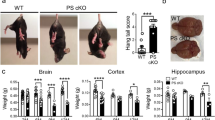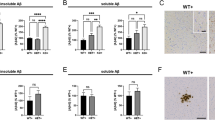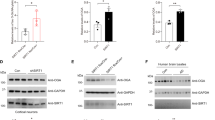Abstract
Neuropathological features in Alzheimer’s Disease (AD) include the presence of hyperphosphorylated forms of the microtubule-associated tau protein (tau) in hippocampal neurones. Numerous studies indicate a neuroprotective effect of calcium-binding proteins (Ca2+ binding proteins) in neurodegenerative diseases (e.g., AD). Secretagogin is a newly described Ca2+ binding protein that is produced by pyramidal neurones of the human hippocampus. Recently, secretagogin expressing hippocampal neurones were demonstrated to resist tau-induced pathology in AD in contrast to the majority of neighbouring neurones. This suggested a neuroprotective effect of secretagogin in hippocampal neurones. Here, we investigated secretagogin expression in wild type (wt) mice as well as in hemizygous and homozygous P301L tau transgenic (tg) mice, which show pronounced and widespread tau pathology in hippocampal neurones. Secretagogin expression was analyzed at the immunohistochemical and biochemical levels in brains of age-matched wt and hemi- and homozygous tau tg mice. In wt mice hippocampal secretagogin-immunoreactive neurones were invariably detected, while immunoreactivity was much lower (P < 0.001) in tau tg mice. Of note, hippocampal secretagogin immunoreactivity was absent in 62.5% of homozygous tau tg mice. In line with this finding, Western blot analysis demonstrated a significant reduction in protein expression levels of secretagogin in homozygous tau tg compared to wt mice. Our results suggest that increased levels of tau negatively influence secretagogin expression in the hippocampus of tau tg mice.





Similar content being viewed by others
References
Abu-Soud HM, Stuehr DJ (1993) Nitric oxide synthases reveal a role for calmodulin in controlling electron transfer. Proc Natl Acad Sci USA 90(22):10769–10772
Alafuzoff I, Arzberger T, Al-Sarraj S, Bodi I, Bogdanovic N, Braak H, Bugiani O, Del-Tredici K, Ferrer I, Gelpi E, Giaccone G, Graeber MB, Ince P, Kamphorst W, King A, Korkolopoulou P, Kovacs GG, Larionov S, Meyronet D, Monoranu C, Parchi P, Patsouris E, Roggendorf W, Seilhean D, Tagliavini F, Stadelmann C, Streichenberger N, Thal DR, Wharton SB, Kretzschmar H (2008) Staging of neurofibrillary pathology in Alzheimer’s disease: a study of the BrainNet Europe Consortium. Brain Pathol 18(4):484–496
Arai H, Emson PC, Mountjoy CQ, Carassco LH, Heizmann CW (1987) Loss of parvalbumin-immunoreactive neurones from cortex in Alzheimer-type dementia. Brain Res 418(1):164–169
Attems J, Quass M, Gartner W, Nabokikh A, Wagner L, Steurer S, Arbes S, Lintner F, Jellinger K (2007) Immunoreactivity of calcium-binding protein secretagogin in the human hippocampus is restricted to pyramidal neurons. Exp Gerontol 42(3):215–222
Attems J, Preusser M, Grosinger-Quass M, Wagner L, Lintner F, Jellinger K (2008) Calcium-binding protein secretagogin-expressing neurones in the human hippocampus are largely resistant to neurodegeneration in Alzheimer’s disease. Neuropathol Appl Neurobiol 34(1):23–32. doi:10.1111/j.1365-2990.2007.00854.x
Birkenkamp-Demtroder K, Wagner L, Brandt Sorensen F, Bording Astrup L, Gartner W, Scherubl H, Heine B, Christiansen P, Orntoft TF (2005) Secretagogin is a novel marker for neuroendocrine differentiation. Neuroendocrinology 82(2):121–138
Blandini F, Braunewell KH, Manahan-Vaughan D, Orzi F, Sarti P (2004) Neurodegeneration and energy metabolism: from chemistry to clinics. Cell Death Differ 11(4):479–484
Braak H, Alafuzoff I, Arzberger T, Kretzschmar H, Del Tredici K (2006) Staging of Alzheimer disease-associated neurofibrillary pathology using paraffin sections and immunocytochemistry. Acta Neuropathol (Berl) 112(4):389–404
Braunewell KH, Gundelfinger ED (1999) Intracellular neuronal calcium sensor proteins: a family of EF-hand calcium-binding proteins in search of a function. Cell Tissue Res 295(1):1–12
Burgoyne RD (2007) Neuronal calcium sensor proteins: generating diversity in neuronal Ca2+ signalling. Nat Rev Neurosci 8(3):182–193
Burgoyne RD, Weiss JL (2001) The neuronal calcium sensor family of Ca2+ binding proteins. Biochem J 353(Pt 1):1–12
Celio RC, Pauls T, Schwaller B (1996) Guidebok to the calcium-binding proteins. Oxford University Press, New York
Dalgarno D, Klevit RE, Levine BA, Williams RJP (1984) The calcium receptor and trigger. Trends Pharmacol Sci 4:266–271
Deters N, Ittner LM, Gotz J (2008) Divergent phosphorylation pattern of tau in P301L tau transgenic mice. Eur J Neurosci 28(1):137–147. doi:10.1111/j.1460-9568.2008.06318.x
Drewes G, Mandelkow EM, Baumann K, Goris J, Merlevede W, Mandelkow E (1993) Dephosphorylation of tau protein and Alzheimer paired helical filaments by calcineurin and phosphatase-2A. FEBS Lett 336(3):425–432
Ferrer I, Soriano E, Tunon T, Fonseca M, Guionnet N (1991) Parvalbumin immunoreactive neurons in normal human temporal neocortex and in patients with Alzheimer’s disease. J Neurol Sci 106(2):135–141
Fonseca M, Soriano E, Ferrer I, Martinez A, Tunon T (1993) Chandelier cell axons identified by parvalbumin-immunoreactivity in the normal human temporal cortex and in Alzheimer’s disease. Neuroscience 55(4):1107–1116
Gandhi CR, Keenan RW (1983) The role of calmodulin in the regulation of dolichol kinase. J Biol Chem 258(12):7639–7643
Gartner W, Lang W, Leutmetzer F, Domanovits H, Waldhausl W, Wagner L (2001) Cerebral expression and serum detectability of secretagogin, a recently cloned EF-hand Ca(2+)-binding protein. Cereb Cortex 11(12):1161–1169
Gotz J, Chen F, Barmettler R, Nitsch RM (2001) Tau filament formation in transgenic mice expressing P301L tau. J Biol Chem 276(1):529–534
Gotz J, Schonrock N, Vissel B, Ittner LM (2009) Alzheimer’s disease selective vulnerability and modeling in transgenic mice. J Alzheimers Dis 18(2):243–251. doi:10.3233/JAD-2009-1143
Greene JR, Radenahmad N, Wilcock GK, Neal JW, Pearson RC (2001) Accumulation of calbindin in cortical pyramidal cells with ageing; a putative protective mechanism which fails in Alzheimer’s disease. Neuropathol Appl Neurobiol 27(5):339–342
Hof PR, Cox K, Young WG, Celio MR, Rogers J, Morrison JH (1991) Parvalbumin-immunoreactive neurons in the neocortex are resistant to degeneration in Alzheimer’s disease. J Neuropathol Exp Neurol 50(4):451–462
Hof PR, Nimchinsky EA, Celio MR, Bouras C, Morrison JH (1993) Calretinin-immunoreactive neocortical interneurons are unaffected in Alzheimer’s disease. Neurosci Lett 152(1–2):145–148
Hof PR, Glezer II, Conde F, Flagg RA, Rubin MB, Nimchinsky EA, Vogt Weisenhorn DM (1999) Cellular distribution of the calcium-binding proteins parvalbumin, calbindin, and calretinin in the neocortex of mammals: phylogenetic and developmental patterns. J Chem Neuroanat 16(2):77–116
Hou Q, Gao X, Zhang X, Kong L, Wang X, Bian W, Tu Y, Jin M, Zhao G, Li B, Jing N, Yu L (2004) SNAP-25 in hippocampal CA1 region is involved in memory consolidation. Eur J Neurosci 20(6):1593–1603
Hou QL, Gao X, Lu Q, Zhang XH, Tu YY, Jin ML, Zhao GP, Yu L, Jing NH, Li BM (2006) SNAP-25 in hippocampal CA3 region is required for long-term memory formation. Biochem Biophys Res Commun 347(4):955–962
Hyman BT (1998) New neuropathological criteria for Alzheimer disease. Arch Neurol 55(9):1174–1176
Iacopino AM, Christakos S (1990) Specific reduction of calcium-binding protein (28 kDa calbindin-D) gene expression in aging and neurodegenerative diseases. Proc Natl Acad Sci USA 87(11):4078–4082
Ikura M (1996) Calcium-binding and conformational response in EF-hand proteins. Trends Biochem Sci 21(1):14–17
Inaguma Y, Shinohara H, Inagaki T, Kato K (1992) Immunoreactive parvalbumin concentrations in parahippocampal gyrus decrease in patients with Alzheimer’s disease. J Neurol Sci 110(1–2):57–61
Leifer D, Kowall NW (1993) Immunohistochemical patterns of selective cellular vulnerability in human cerebral ischemia. J Neurol Sci 119(2):217–228
Leuba G, Kraftsik R, Saini K (1998) Quantitative distribution of parvalbumin, calretinin, and calbindin D-28 k immunoreactive neurons in the visual cortex of normal and Alzheimer cases. Exp Neurol 152(2):278–291
Maj M, Gartner W, Ilhan A, Neziri D, Attems J, Wagner L (2010) Expression of TAU in insulin-secreting cells and its interaction with the calcium-binding protein secretagogin. J Endocrinol 205(1):25–36. doi:10.1677/JOE-09-0341
Mirra SS, Hart MN, Terry RD (1993) Making the diagnosis of Alzheimer’s disease. A primer for practicing pathologists. Arch Pathol Lab Med 117(2):132–144
Mulder J, Zilberter M, Spence L, Tortoriello G, Uhlen M, Yanagawa Y, Aujard F, Hokfelt T, Harkany T (2009) Secretagogin is a Ca2+ binding protein specifying subpopulations of telencephalic neurons. Proc Natl Acad Sci USA 106(52):22492–22497. doi:10.1073/pnas.0912484106
Nitsch C, Scotti A, Sommacal A, Kalt G (1989) GABAergic hippocampal neurons resistant to ischemia-induced neuronal death contain the Ca2(+)-binding protein parvalbumin. Neurosci Lett 105(3):263–268
Pennanen L, Welzl H, D’Adamo P, Nitsch RM, Gotz J (2004) Accelerated extinction of conditioned taste aversion in P301L tau transgenic mice. Neurobiol Dis 15(3):500–509. doi:10.1016/j.nbd.2003.11.020S
Rogstam A, Linse S, Lindqvist A, James P, Wagner L, Berggard T (2007) Binding of calcium ions and SNAP-25 to the hexa EF-hand protein secretagogin. Biochem J 401(1):353–363
Satoh J, Tabira T, Sano M, Nakayama H, Tateishi J (1991) Parvalbumin-immunoreactive neurons in the human central nervous system are decreased in Alzheimer’s disease. Acta Neuropathol (Berl) 81(4):388–395
Scharfman HE, Schwartzkroin PA (1989) Protection of dentate hilar cells from prolonged stimulation by intracellular calcium chelation. Science 246(4927):257–260
Skelton NJ, Kordel J, Akke M, Forsen S, Chazin WJ (1994) Signal transduction versus buffering activity in Ca(2+)-binding proteins. Nat Struct Biol 1(4):239–245
Solomon B, Koppel R, Jossiphov J (2001) Immunostaining of calmodulin and aluminium in Alzheimer’s disease-affected brains. Brain Res Bull 55(2):253–256
Thibault O, Porter NM, Chen KC, Blalock EM, Kaminker PG, Clodfelter GV, Brewer LD, Landfield PW (1998) Calcium dysregulation in neuronal aging and Alzheimer’s disease: history and new directions. Cell Calcium 24(5–6):417–433
Wagner L, Oliyarnyk O, Gartner W, Nowotny P, Groeger M, Kaserer K, Waldhausl W, Pasternack MS (2000) Cloning and expression of secretagogin, a novel neuroendocrine- and pancreatic islet of Langerhans-specific Ca2+ binding protein. J Biol Chem 275(32):24740–24751
Zhan X, Evans CO, Oyesiku NM, Desiderio DM (2003) Proteomics and transcriptomics analyses of secretagogin down-regulation in human non-functional pituitary adenomas. Pituitary 6(4):189–202
Zierhut B, Daneva T, Gartner W, Brunnmaier B, Mineva I, Berggard T, Wagner L (2005) Setagin and secretagogin-R22: posttranscriptional modification products of the secretagogin gene. Biochem Biophys Res Commun 329(4):1193–1199
Acknowledgments
This work was supported by the Newcastle NIHR Biomedical Research Centre In Ageing and Age Related Diseases, the Alzheimer Research Trust (ART-EG2010A-1) and by the Medical Scientific Fund of the Mayor of the City of Vienna (Grant number 08052). Mathias Heikenwalder was supported by the Prof. Dr. Max-Cloëtta foundation, the Hofschneider Stiftung and the Helmholtz-Zentrum München. The authors thank Ms. Barbara Weidinger for excellent laboratory work.
Author information
Authors and Affiliations
Corresponding author
Rights and permissions
About this article
Cite this article
Attems, J., Ittner, A., Jellinger, K. et al. Reduced secretagogin expression in the hippocampus of P301L tau transgenic mice. J Neural Transm 118, 737–745 (2011). https://doi.org/10.1007/s00702-011-0626-5
Received:
Accepted:
Published:
Issue Date:
DOI: https://doi.org/10.1007/s00702-011-0626-5




